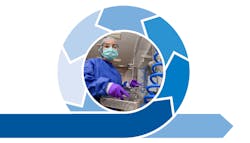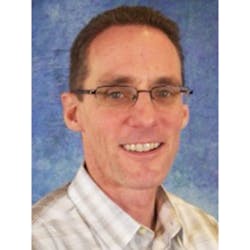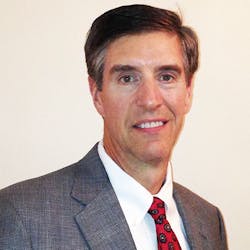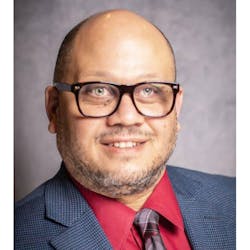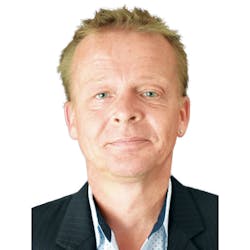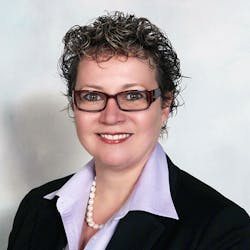With patient case volumes rebounding from pandemic-related slow-downs, Central Service/Sterile Processing & Distribution (CS/SPD) departments are once again working diligently to safely and quickly turn around instruments and devices for use in the operating room (OR) and other procedural areas.
But it is not back to business as usual. Hospitals are struggling from significant financial losses and CS/SPD teams from staff shortages due to furloughs and layoffs over the past year. Forced to do more with less money and fewer people, CS/SPDs are taking a hard look at the efficiency of their operations, how they measure it and how they can improve it.
Staff shortages straining
“During the pandemic, some hospitals allowed departments to lose staff through attrition and are now scrambling to refill those positions. While the workflows are the same, the backlogs have grown.”
Those departments that bring on new, inexperienced staff members struggle to train them at a time when case volumes have been rising, which presents a major drag on productivity, according to Agoston. Adding to the burden is frequent CS/SPD staff turnover as a result of low wages and a competitive job market.
“New staff come with training needs, placing more stress on educators and existing staff,” said Agoston. “Many hospitals report that new staff is often lured away to clinics, surgery centers or other employers outside of healthcare due to better pay. Sometimes 25 cents per hour is all it takes to lose an employee. Hospital staff have commented that they are tired of spending time training new staff who will ‘last a year or less in the department.’”
“It is yet to be seen if this labor shortage is temporary or the ‘new normal,’” he added. “If it is the new normal, then hospitals will need to do a deep dive to solve the root causes preventing them from attracting and retaining qualified staff. In the interim, this disruption in staffing is negatively affecting workflows and has the potential to negatively affect patient outcomes.”
Kimsey adds how the tremendous financial burden of the pandemic on many hospitals has forced them to focus their recovery plans on “pure financial efficiency,” such as full-time employees (FTEs) per surgery case or FTEs per instrument tray processed.
“These types of efficiency measurements and definitions rarely take into account the clinical requirements, such as following instructions for use (IFU), that are required to ensure patient standard of care,” Kimsey indicated. “Efficiency is best described as meeting clinical needs first while minimizing operational waste. This way, SPD managers can set the baseline of labor requirements based on IFUs and clinical needs and then measure how well they are performing to that baseline.”
How SPDs measure efficiency
The term “efficiency” can mean many different things in the CS/SPD realm. Not surprisingly, this translates to departments measuring process efficiency in various ways.
“We frequently see CS/SPD departments measuring efficiency utilizing obsolete models that don’t reflect the reality of their departments today,” Ramos added. “For example, we still see CS/SPD efficiency measured by surgery minutes. However, surgery is only a representation of the work carried out in the department. Efficiency without accurate data can be the same as inefficiency.”
Available trays
“Efficiency is certainly a top priority as CSDs want to get the most throughput without sacrificing quality,” said Brigance. “If there are bottlenecks in the process, this could lead to delayed or canceled OR procedures due to instrumentation not being readily available, which in turn is a major loss of revenue for the hospital and or facility.”
Tray turnaround time
“Tray turnaround time (arrival to CS/SPD through process to sterile storage) is arguably the most important data point to assist with instrument inventory planning and case scheduling,” he stated. “Scan stations and use of an instrument tracking system are critical for understanding this metric. Most departments without instrument tracking rely heavily on case delays, add-ons, and other statistics to measure efficiency.”
Brigance describes the ability to time stamp each scanning point in the process through T-DOC, an instrument tracking system that generates data and reports for efficiency monitoring and measurement.
“Reports can show where the bottlenecks might be and therefore issues can be addressed and hopefully resolved,” he explained. “In addition to efficiency, quality can also be tracked as many facilities will document any issues with the sets that may have happened either in SPD or after use in the OR,” he added.
“SPDs are constantly striving towards a more efficient department,” said Polston. “Departments are now more than ever focusing on metrics (KPIs – key performance indicators) to help understand current performance and opportunities for improvement. These metrics are compiled using processing volumes and processing times calculated by analyzing scan times for instrument sets throughout the process (arrival to SPD all the way through sterile storage). Instrument tracking systems are critical for obtaining accurate date to provide these metrics.”
Number of items sterilized
Agoston points to the number of items sterilized as another metric CS/SPDs use to track efficiency. But he says the downside of this approach is the variation in how items are counted.
“Some track items sterilized, but the challenge is that each set or peel pouched item counts as one,” said Agoston. “Some sets can contain over 100 instruments. A peel pouch contains one instrument. Both are counted as one. While there may be some benefit to watching the count of sterilized items over time, it does not accurately represent the work performed.”
Other departments track the number of instruments processed, but the problem with this approach is that not all instruments processed are recorded in the instrument tracking system, as Agoston explains:
“For instance, loaner instruments are often delivered for Ortho/ Neuro/ Spine surgery without a count sheet. Most hospitals track these sets as a count of one, when in fact many of these sets contain 30 to 100 instruments or more. In a hospital with heavy volume of Ortho/Neuro/ Spine procedures, measuring instrument processed will not be representative of the work performed.”
Connecting time to volume
Kimsey notes how he has seen “good improvements” over the years in CS/SPDs becoming more adept at measuring efficiency. He explains how instrument tracking systems have enabled departments to calculate efficiency in terms of time to volume, which is a much more accurate measurement compared with other metrics.
“While historically tray volumes were reported as ‘productivity’ or ‘efficiency’ metrics without a correlation to labor spent, today instrument tracking systems provide data that enables CS/SPDs to correlate time to volume and thus create true efficiency calculations,” he stated. In the end, some departments’ final efficiency calculations come from their finance department, in terms of hours worked per item processed, while other departments focus on internal processes, such as trays assembled per hour per technician.”
Kimsey says most hospitals have made the investment in instrument tracking systems over the last 20 years, which has helped efficiencies tremendously. He adds that the adoption of lean methodologies, such as visual management, 5S, standard work and leadership routines have also been “most useful and impactful.”
“CS/SPDs are realizing the more they standardize their operations and provide tools to their technicians, the more efficient they are,” he added.
Power of data usage
Data on CS/SPD efficiency alone is “worthless,” according to Ramos. True value is derived when teams integrate data from instrument tracking and OR scheduling systems and use it to effectively manage workflow.
“Using the correct algorithm, we can forecast staffing, capacity and many other measurable components to optimize and synchronize Sterile Processing and Surgery operations,” he commented. “We have seen more and more SPD leaders access data from multiple systems to help them drive efficiency and create a more seamless approach to an effective workflow.”
Aesculap powered by Ascendco recently introduced a solution to the U.S. market to address this need. The companies align Aesculap Surgical Asset Management expertise and solutions with Ascendco aggregate data and provide healthcare systems with a workflow based on that data.
Factors that boost efficiency
Once a CS/SPD determines how it will define efficiency, the next step is putting into place a plan to streamline operations while maintaining, or even improving, quality and safety. In many cases it comes down to a combination of people, processes and technology.
OR collaboration and integration
The workflows of the CS/SPD and OR are directly linked – with the OR’s procedures dictating which instruments and trays must be available for use on any given day. Therefore, it is critical that CS/SPD and OR teams closely collaborate and communicate on requirements and expectations.
Interfacing the CS/SPD instrument tracking system with the OR scheduling system is one way to improve coordination between the two departments, explains Brigance.
“When these tracking systems are interfaced with an OR scheduling system, the SPD staff knows exactly what instrument sets are needed for upcoming cases and what still needs to be picked and delivered. Furthermore, T-DOC sterile supply management solution can automatically prioritize instrument sets based on availability giving the SPD staff a clear picture of what sets need attention first.”
CS/SPD staff education
CS/SPD staff shortages related to the pandemic have forced many departments to hire new and inexperienced technicians, which puts greater strain on department efficiency. As a result, there has been increased demand for STERIS education offerings across the country, according to Kimsey. To help with education efforts, the company has launched a new IFU software that “provides our employees the information they need when they need it,” he added.
“The software focuses on decontamination and provides IFU-based information to the technician at the sink,” he said. “Similar to a fast-food order entry screen showing the orders in process and time elapsed, the software provides step-by-step guidance to cleaning the instruments with built-in countdown timers. No more having to rely on your memory to know what to do.”
See sidebar: Efficient electrophysiology cable sterilization can land hospitals in hot water.
“The focus of the Joint Commission seems to be on confirming SPD cleaning methodology is standardized across device categories and follow the appropriate instructions for use,” said Thording. “We do not know what has caused this focus, but the introduction of more single-use EP cables that cannot be sent to the SPD could be a contributing factor. Hospitals are just not used to distinguishing between different EP cable types.
“CS/SPDs must ensure their staff members can actually identify individual cables and treat them according to their specific use instructions,” he added. “If not, there is a risk that single-use cables are reused several times, cleaning is inadequate or no testing is conducted.”
Ramos recommends CS/SPD leaders provide their staff members job aids, pictures and diagrams, which he describes as “great tools” to support staff in different process steps.
“A comprehensive and precise count sheet is essential for the consistent completion of the set with no variance,” Ramos added.
Training CS/SPD technicians as specialists in specific procedural areas and related instrumentation can boost process efficiency both in the CS/SPD and the OR, according to Agoston. He notes that the most common areas for specialization are arthroplasty services and minimally invasive surgery, including gastrointestinal (GI) endoscopy.
“The number one tool to improve efficiency in SPD is the introduction of specialization. The challenge is in breaking the old standard that everyone must be trained and perform all SPD functions. Specialists trained to process the instruments and assist with OR set-up, take-down and troubleshooting ensure that the OR is operating at its peak of efficiency. SpecialtyCare can provide assistance with transforming your SPD into a highly efficient operation.”
To assist with OR efficiency measurement and improvements, SpecialtyCare offers a software solution called OR Insight, which provides analysis on key OR performance metrics, including OR usage, block scheduling and cost of supplies and implants, down to the surgeon level. It can be used in conjunction with several instrument management software programs.
Automated equipment
In an effort to increase efficiency, standardize processes and improve both patient and staff safety, more and more CS/SPDs are implementing automated processing equipment. By minimizing manual labor, departments can reduce variation (which increases quality), streamline workflows and reduce the risk for staff injuries.
“Equipment automation is another critical component for efficiency improvement to keep the process moving and improving instrument turnaround times,” said Polston. “One of the more exciting technologies has been the addition of automation to the washers and sterilizers.”
As Polston explains, sets are getting complex and heavier; therefore, when CS/SPD staff members manually push washer and sterilizer transport carts they face greater risk for lower back and hand injuries. Washers and sterilizers that feature automated loading, unloading and transport relieve them of strenuous, physical steps in the process.
“In today’s ever evolving SPD, the ergonomic challenges the clinicians experience are an area of concern,” he said. “Workplace incidents negatively impact the staffing of the SPD and can have a detrimental impact on meeting productions needs of the department. Having these ensure the instruments keep moving to meet production needs in a safe and efficient means has reduced injuries.”
Workspace design
Ramos recommends that manufacturers’ IFUs be consulted during the design and planning of workspaces to ensure technicians can safely reprocess surgical instruments. To help protect staff from injuries, he recommends sets be limited to under 25 pounds and storage locations organized based on set weight, with heavier items stored waist high and lightweight items on top and bottom shelves.
Height adjustable processing sinks, workstations and assembly tables that adjust to the various heights of the employees are growing in popularity as well, as departments seek new solutions for improved ergonomics.
“These allow the technician to adjust the height of the work area to fit their needs. Ask anyone who has been bent over a sink decontaminating instruments all day and they will tell you that these adjustable height workstations are very beneficial,” noted Agoston.
“All materials needed such as integrators, tamper proof locks, filters, replacement instrumentation, etc. should be organized in the order which they are used and within arm’s reach,” she stated. “Mark the locations to be alerted when something is out of place. Standardizing all workstations with the same set up not only will increase efficiency but also reduce instrument set assembly errors.”
Error reduction
Reprocessing instruments right the first time saves time and labor downstream. As Agoston explains, events such as holes in wrap, missing instruments, dirty instruments, missing sterilization integrators and sterilization failures add work for CS/SPD professionals, can result in case delays in the OR and put patient safety at risk.
Agoston stresses the need to accurately track these events so that the CS/SPD can address these issues and make continuous improvements to its processes.
“These unrecorded events can have a substantial negative impact on efficiency of the OR and SPD,” he said. “Real-time event information is critical to a highly functioning SPD. You can’t solve a problem that you do not know you have. Having a comprehensive and accurate event reporting system is a critical need for all facilities treating patients. Every event, whether or not it impacts the patient, is important to track so that problem areas can be identified and corrected.”
Service programs
Keeping equipment in the CS/SPD up and running is another critical factor to maintaining high efficiency and productivity levels. Understanding the correlation between properly functioning washers, sterilizers and other key machinery and prompt instrument turn-around times, a growing number of CS/SPDs are making investments in preventive maintenance (PM) programs.
“Equipment service programs are shifting to provide maintenance on a frequency determined by equipment usage (cycle counts versus arbitrary frequency) to improve equipment uptime,” said Polston.
How to get leadership buy-in
For hospitals struggling with the financial consequences of the pandemic and efforts focused on revenue generating areas, including the OR, it might seem like a tough time for the CS/SPD to secure resources for improvements. Educating hospital leaders on the critical link between effective and efficient CS/SPD operations and successful surgical procedures can help pave the way for investments in the department.
“Healthcare leadership is constantly challenged to improve workflows, eliminate waste, reduce costs and improve efficiency,” said Ramos. “Post-pandemic, that need is more evident than ever, as leaders realize the need to align workflows based on solid data points.”
In an effort to gain support for its efficiency and quality improvements, the CS/SPD team at Fairfield Medical Center, a 222-bed, nonprofit, 501(C)3 hospital in Lancaster, OH, brought the hospital’s chief executive officer (CEO), chief operating officer (COO), chief nursing officer (CNO) and head of epidemiology and infection control into the department for a hands-on lesson in tray assembly. The effort was led by Steven Teaford, Sterile Processing Manager, SpecialtyCare, who provides sterile processing consulting services to the department.
They set each member of the leadership team down in front of an instrument set and gave them basic instructions on assembly. About 99% of the time the leader would get to the third instrument in the set and raise an issue, according to Teaford, whether it was a missing or mislabeled instrument, or one that appeared compromised in some way. In many cases, when a member of the CS/SPD team sought out a replacement item in storage there was no item available, or the back-up item was also in poor shape.
“A lot of good things have happened since we brought them down here to actually see the struggles we have,” noted Teaford. “Our credibility among leadership has increased, so when we ask for something they understand that it is something we truly need.”
See sidebar for details on Fairfield Medical Center’s CS/SPD efficiency improvements.
Efficient electrophysiology cable sterilization can land hospitals in hot water
Balancing effective and safe reprocessing of reusable instruments and devices with the pressure for efficiency is a significant struggle for Central Service/Sterile Processing & Distribution (CS/SPD) department professionals. Joint Commission compliance is at risk when staff members are pressured to streamline or skip steps necessary to deliver a clean and sterilized item into the hands of clinicians.
Lars Thording, Vice President of Marketing and Public Affairs, Innovative Health, says reusable electrophysiology (EP) cables are a good example of items that require a critical eye and attention to detail when reprocessed in accordance with Joint Commission standards. He explains how reusable cables come with instructions on how to clean and make ready for another use, but with hundreds of different cables that look alike, CS/SPD teams face challenges in identifying each type of cable and its individualized cleaning methods.
“Most cleaning instructions are very broad, as in, ‘The cable can withstand cleaning with soap solutions or alcohol,’ while others are more extensive and specific; they may require special treatment of the connector or even testing before reuse,” he said. “Add to this that EP cables come with an FDA-regulated maximum number of times the cable can be used.”
Most CS/SPD departments don’t have the capacity or work routines to ensure cables are cleaned exactly to instructions, that they are tested, and that the number of uses are counted, according to Thording.
“There is an unfortunate trade-off between efficiency and compliance with Joint Commission rules here, and frequently, efficiency becomes the guiding principle,” he added. “Recently, we have heard from a number of our hospital partners that the Joint Commission has honed in on these practices and demanded change.”
By outsourcing the reprocessing of items that require complex work routines, such as EP cables, a CS/SPD department can remain efficient in its operations while adhering to Joint Commission rules, Thording explains.
“Reusable EP cables can legally be reprocessed by the Central Sterile department, but it comes with regulatory risk,” he stated. “We have seen more and more hospitals sending their EP cables to third-party reprocessing companies that have the capacity to accurately identify, serial tag, clean, test and sterilize these cables. Moreover, serial tagging allows for accurate count of number of uses. This helps the hospital remain efficient, yet also comply with Joint Commission rules and avoid the operational disruption of having to replace cables during procedures.”
A lesson in gaining leadership support for efficiency improvements
Post-COVID, Fairfield Medical Center has gained leadership buy-in for CS/SPD improvements that are increasing both the efficiency of its operations and the quality of instruments delivered to procedural areas. These include:
• Improved water quality to protect instruments and equipment from damage (e.g., scale formation, corrosion), staining and discoloration. Keeping these assets functioning and available reduces downtime and the extra time/labor required to switch compromised instruments out of trays.
• Engagement with a sterilization wrap recycling provider where the operating room (OR) staff places used wrap in a designated container, rather than sending it to the CS/SPD for disposal. Saved time and labor in the CS/SPD since they no longer are taking out the OR’s “trash.”
• New hire education program, which includes a certification class with hands-on training on instrument handling, cleaning, assembly and sterilization, and mentoring by an experienced staff member. Boosts efficiency by enabling new technicians to get up to speed quicker on the right way to process instrumentation. It has also decreased the tray assembly error rate down to less than 1%, minimizing the need for time-consuming rework.
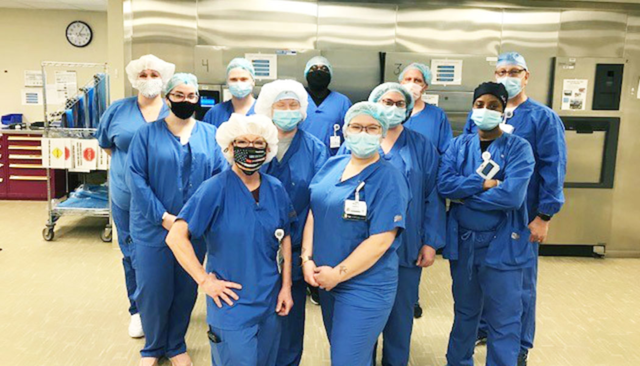
About the Author
Kara Nadeau
Senior Contributing Editor
Kara Nadeau is Sterile Processing Editor for Healthcare Purchasing News.
